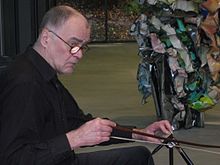Daxophone
The daxophone is a musical instrument , belongs to the idiophone family and is an instrument from the field of experimental music. It was developed by the guitarist Hans Reichel from Wuppertal and is suitable for self-assembly.
A daxophone is a wooden board painted with a cello or bass bow, the sounding end of which can be changed in pitch and timbre with a handy block. A sound box is mechanically connected to the board, which can be shaped in different ways.
The line of the bow stimulates the wooden board as the actual sound generator to vibrate. This board, based on Reichel's experience, is an average of 330 mm long, 30 mm wide and 5 mm thick, is connected at one end to the resonance box by means of a clamping device, to which pickups or contact microphones are connected, which forward the acoustic signal electrically to the amplifier and loudspeaker. The other end of the board is floating. Its vibration behavior (thus the pitch and the timbre) is manipulated by a flat wooden wedge, the Dax . This should be slightly curved on at least one side so that it can be rocked back and forth on the board with light pressure, similar to a rocking chair.
The tones generated sometimes sound similar to a singing saw , sometimes very surreal, but can be noisy.
Its construction and functionality have been presented in detail in American, Japanese and European journals, and his music can be heard on numerous solo LPs and CDs by, for example, Hans Reichel, Kazuhisa Uchihashi , Daniel Fishkin and Michael Hearst .

